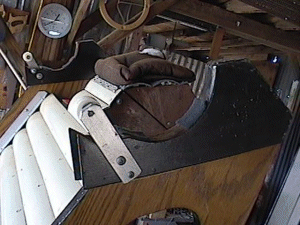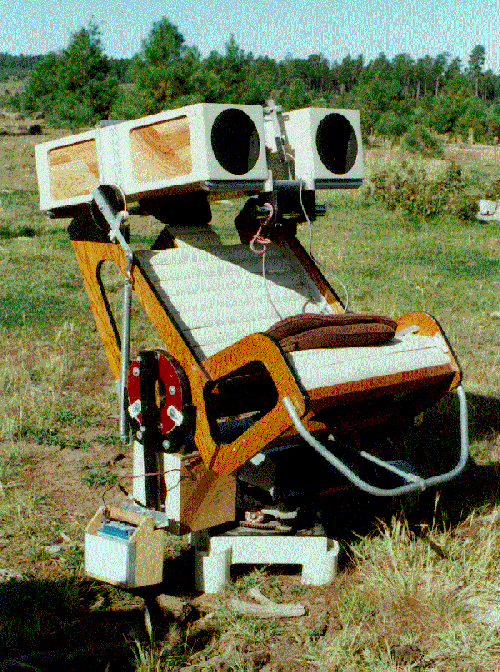 | This view is of the
top of the chair section and shows the cradle for the OTA. Bearing surface is only felt pads here. The rollers
keep the OTA from sliding off the front, I think. Just in front of the rollers, you see a black material, hardboard,
that extends further in front and has a point facing upwards. One of these points is broken off and will be repaired.
Their funtion isn't known at this time, but once the OTA is again in the cradle, I'm sure their function will become
clear.
Anyway, the bearing surfaces arrangement will be evaluated once the chair is together, and I wouldn't rule
out teflon and Ebony Star in their future. :-) |
 | The OTA assembly from
the business end. This picture is kind of busy, so it's hard to tell what's going on here. Answer: Mostly nothing.
You can see the main mirrors and their associated secondaries mounted on single strips of aluminum inside the tubes.
The front of the focusing mechanism is visible and its associated colimation screws, but not very clearly. Also, you
can see the chrome tube in front, used for lifting the assembly on its bearings for access to the chair. the front
brace holding the tubes together is also seen. |
 | This oblique view is
slightly better. The entire left optical tube is seen, with the left side bearing and clip to accept the spring from t
he chair assembly. The center aluminum brace is seen ot top. The angled piece of aluminum stock between the tubes is
the actuator for the headrest adjustment. Another example of mystery that should become obvious once the whole thing
is assembled. |
 | This oblique view is
slightly better. The entire left optical tube is seen, with the left side bearing and clip to accept the spring from t
he chair assembly. The center aluminum brace is seen ot top. The angled piece of aluminum stock between the tubes is
the actuator for the headrest adjustment. Another example of mystery that should become obvious once the whole thing
is assembled. |
 | From the back, it looks like
about any small scope, except there's two of them. I really hope collimation isn't achieved using the mirror cell straps
seen at 3 points around the mirrors here. >eek<
At any rate, the top and rear bracing tubes are clearly seen, as is
a better view of the left alt bearing. |
 | Here's a good view of
the focuser section from the front. The angled aluminum strip on the right is the headrest actuator. Lower left is the
focuser knob-a leather bushing held tight between a couple washers and mounted on a rod that rotates the gear on top.
A transversal gear meshes yet another gear that moves the whole shebang toward and away from the viewer. The hollow tube
seen at the top of this assembly is the sliding carriage for the eyepieces, not seen behind.
Just above the focuser
knob is seen the 6x30 finder scope. Above and to the right of the finder's objective is the collimation section. These
are the adjustment for ligning up the separate scopes to come together at the eyepieces. The first time through, I didn't
get to figure these out. They didn't seem to do what I wanted them to do, so my assessment here may be all wet. Perseverence
will prevail though. :-) |
 | I could have gotten slightly
closer on this one, but here goes anyway.
This is where you look to be amazed. It's also one of the only parts I was
able to work on right after I got the chair. The old version had a couple of teardrop shaped aluminum pieces with 1.25" holes
cut in them to mount presumably matching eyepieces. The were connected at the narrow end of the teardrops and moved relative
to each other to adjust the interocular distance, as in a binocular of reasonable size. Those I'm in contact with are unanimous
in their consternation at this particular adjustment. My philosophy in this is, if it's a binocular chair, why not use a binocular i
nterocular adjustment? I happened to have a pair of binoculrs that were beyond help, the prisms having been knocked tragically out
of alignment, so I borrowed the eyepieces AND interocular adjustment and installed them on the focuser here. Now, once again, I haven't
had much chance to play with this arrangement, but what I did see, seemed to work well. More refinements are in order.
Anyway, in
this view is seen the above mentioned bino EP's, the finder scope EP at lower right, the back side of the focuser gearing, along with
an obscured view of the focus knob and the headrest adjustment lever. |
 | Ok, same view from farther back shows all
of the above and the business end of the headrest adjustment lever. (Yeah, that square, plastic block with the round hole in it. You're
guess is as good as mine...) |
 | Ok, same view from farther back shows all
of the above and the business end of the headrest adjustment lever. (Yeah, that square, plastic block with the round hole in it. You're
guess is as good as mine...) |

